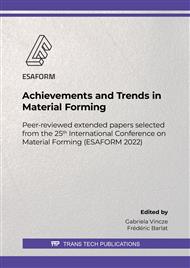[1]
FAA. AC 20-107A: Composite Aircraft Structure. vol. 1. (2010).
Google Scholar
[2]
FAA. AC 20-107B: Composite Aircraft Structure. vol. 1. (2010).
Google Scholar
[3]
Vlot A. Low-velocity impact loading: On fibre reinforced aluminium laminates (ARALL and GLARE) and other aircraft sheet materials. Delft: Delft University of Technology; (1993).
Google Scholar
[4]
Airbus Magazine Fast 48 (2011).
Google Scholar
[5]
Abrate S. Impact on laminated composite materials. Appl Mech Rev 1991;44:155–90. https://doi.org/10.1115/1.3119500.
Google Scholar
[6]
Abrate S. Impact on laminated composites: Recent advances. Appl Mech Rev 1994;47:517–44. https://doi.org/10.1115/1.3111065.
Google Scholar
[7]
Falaschetti MP, Scafè M, Troiani E, Agostinelli V, Sangiorgi S. Experimental Determination of Compressive Residual Strength of a Carbon/epoxy Laminate after a Near-edge Impact. Procedia Eng., vol. 109, Elsevier Ltd; 2015, p.171–80. https://doi.org/10.1016/j.proeng.2015.06.229.
DOI: 10.1016/j.proeng.2015.06.229
Google Scholar
[8]
Falaschetti MP, Scafè M, Tatì A, Troiani E. Experimental determination of thickness influence on compressive residual strength of impacted carbon/epoxy laminate. Procedia Struct. Integr., vol. 3, Elsevier B.V.; 2017, p.237–45. https://doi.org/10.1016/j.prostr.2017.04.056.
DOI: 10.1016/j.prostr.2017.04.056
Google Scholar
[9]
Asundi A, Choi AYN. Fiber metal laminates: An advanced material for future aircraft. J Mater Process Technol 1997;63:384–94. https://doi.org/10.1016/S0924-0136(96)02652-0.
DOI: 10.1016/s0924-0136(96)02652-0
Google Scholar
[10]
Laliberte J, Poon C, Straznicky PV, Fahr A. Applications of fiber-metal laminates. Polym Compos 2000;21:558–67.
DOI: 10.1002/pc.10211
Google Scholar
[11]
Krishnakumar S. Fiber Metal Laminates — The Synthesis of Metals and Composites. Http://DxDoiOrg/101080/10426919408934905 2007;9:295–354. https://doi.org/10.1080/10426919408934905.
Google Scholar
[12]
Sadighi M, Alderliesten RC, Benedictus R. Impact resistance of fiber-metal laminates: A review. Int J Impact Eng 2012;49:77–90. https://doi.org/10.1016/J.IJIMPENG.2012.05.006.
DOI: 10.1016/j.ijimpeng.2012.05.006
Google Scholar
[13]
Sadighi M, Pärnänen T, Alderliesten RC, Sayeaftabi M, Benedictus R. Experimental and Numerical Investigation of Metal Type and Thickness Effects on the Impact Resistance of Fiber Metal Laminates n.d. https://doi.org/10.1007/s10443-011-9235-6.
DOI: 10.1007/s10443-011-9235-6
Google Scholar
[14]
Chaboche JL. Continuum Damage Mechanics: Part I—General Concepts. J Appl Mech 1988;55:59–64. https://doi.org/10.1115/1.3173661.
DOI: 10.1115/1.3173661
Google Scholar
[15]
Chaboche JL. Continuum Damage Mechanics: Part II—Damage Growth, Crack Initiation, and Crack Growth. J Appl Mech 1988;55:65–72. https://doi.org/10.1115/1.3173662.
DOI: 10.1115/1.3173662
Google Scholar
[16]
Camanho PP, Dávila CG. Mixed-Mode Decohesion Finite Elements for the Simulation of Delamination in Composite Materials. (2002).
Google Scholar
[17]
Faggiani A, Falzon BG. Predicting low-velocity impact damage on a stiffened composite panel n.d. https://doi.org/10.1016/j.compositesa.2010.02.005.
Google Scholar
[18]
Johnson HE, Louca LA, Mouring S, Fallah AS. Modelling impact damage in marine composite panels q 2008. https://doi.org/10.1016/j.ijimpeng.2008.01.013.
DOI: 10.1016/j.ijimpeng.2008.01.013
Google Scholar
[19]
Hashin Z. Failure criteria for unidirectional fiber composites. J Appl Mech Trans ASME 1980;47:329–34. https://doi.org/10.1115/1.3153664.
Google Scholar
[20]
Benzeggagh ML, Kenane M. Measurement of mixed-mode delamination fracture toughness of unidirectional glass/epoxy composites with mixed-mode bending apparatus. Compos Sci Technol 1996;56:439–49. https://doi.org/10.1016/0266-3538(96)00005-X.
DOI: 10.1016/0266-3538(96)00005-x
Google Scholar
[21]
Shi Y, Swait T, Soutis C. Modelling damage evolution in composite laminates subjected to low velocity impact. Compos Struct 2012; 94: 2902–13. https://doi.org/10.1016/j.compstruct. 2012.03.039.
DOI: 10.1016/j.compstruct.2012.03.039
Google Scholar


